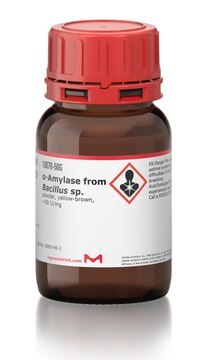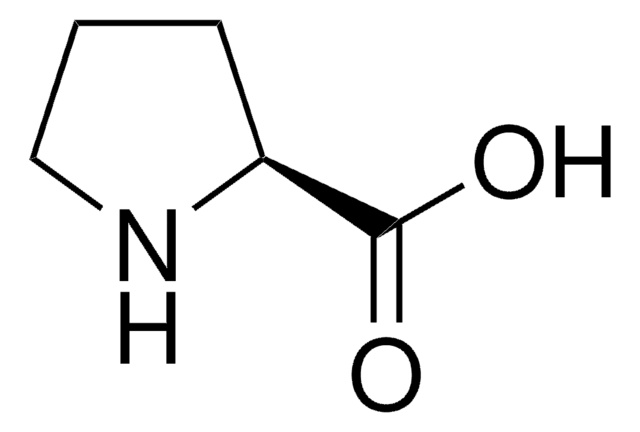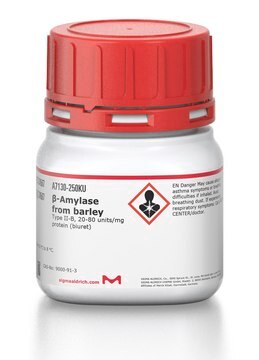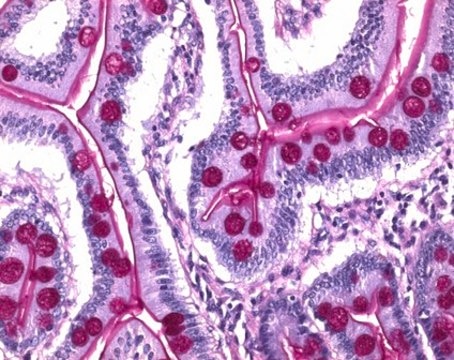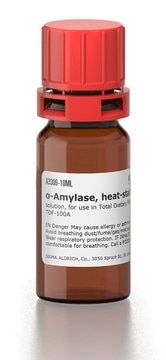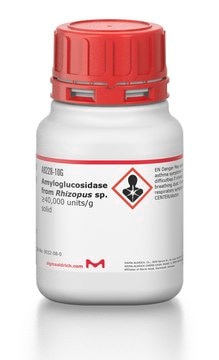09962
Diastase from Aspergillus oryzae
powder, white, amylase ≥3500 U/g
Sign Into View Organizational & Contract Pricing
All Photos(1)
About This Item
Recommended Products
Related Categories
Application
Diastase from Aspergillus oryzae has been used:
- to distinguish sulphomucins and sialomucins
- to discriminate acidic mucins from neutral mucins in the lingual salivary glands
- as a component of the BioVision amylase activity assay buffer solution for in vitro and ex vivo degradation assays
Biochem/physiol Actions
Diastase catalyzes the digestion of glycogen. It is useful as a reducing and stabilizing agent in the aqueous synthesis of gold nanoparticles (AuNPs).
Unit Definition
1 U corresponds to the amount of enzyme which liberates 1 μmol maltose per minute at pH 6.0 and 25 °C (starch acc. to Zulkowsky, Cat. No. 85642, as substrate)
signalword
Danger
hcodes
pcodes
Hazard Classifications
Resp. Sens. 1
Storage Class
11 - Combustible Solids
wgk_germany
WGK 1
flash_point_f
Not applicable
flash_point_c
Not applicable
ppe
dust mask type N95 (US), Eyeshields, Faceshields, Gloves
Certificates of Analysis (COA)
Search for Certificates of Analysis (COA) by entering the products Lot/Batch Number. Lot and Batch Numbers can be found on a product’s label following the words ‘Lot’ or ‘Batch’.
Already Own This Product?
Find documentation for the products that you have recently purchased in the Document Library.
Customers Also Viewed
Ultrastructure of the tongue and histochemical features of the lingual salivary glands in buzzards
Bozkurt EU, et al.
Turkish Journal of Veterinary and Animal Sciences, 42, 161-167 null
Kesarla Mohan Kumar et al.
Spectrochimica acta. Part A, Molecular and biomolecular spectroscopy, 116, 539-545 (2013-08-27)
A facile rapid green eco-friendly method to synthesize gold nanoparticles (Au NPs) of tunable size using aqueous Terminalia arjuna fruit extracts has been demonstrated herein. Formation of Au NPs was confirmed by Surface Plasmon Resonance (SPR) study at 528 nm
F Başak et al.
Folia morphologica, 76(3), 348-354 (2017-02-16)
In this study, morphological characteristics of the canary tongue were examined macroscopically and histologically besides using scanning electron microscopy. Furthermore, histochemical features of the lingual salivary glands of the canary were also examined. The results suggest that the tongue of
Our team of scientists has experience in all areas of research including Life Science, Material Science, Chemical Synthesis, Chromatography, Analytical and many others.
Contact Technical Service